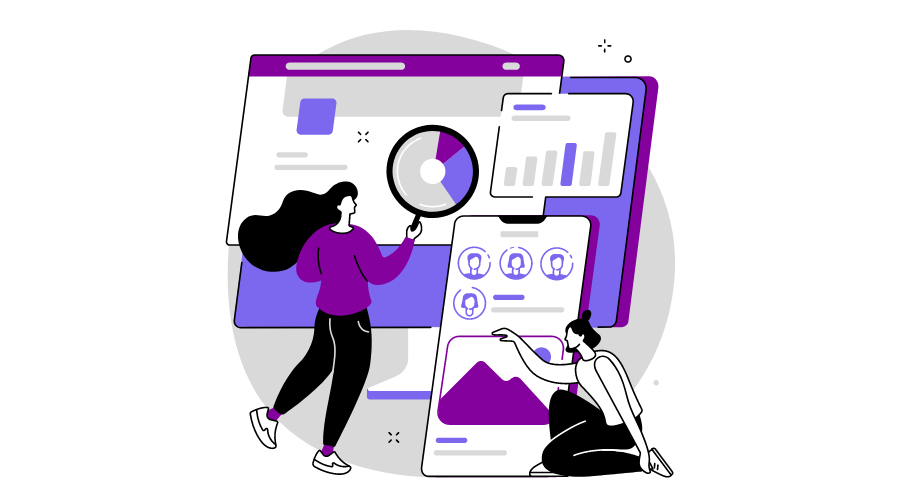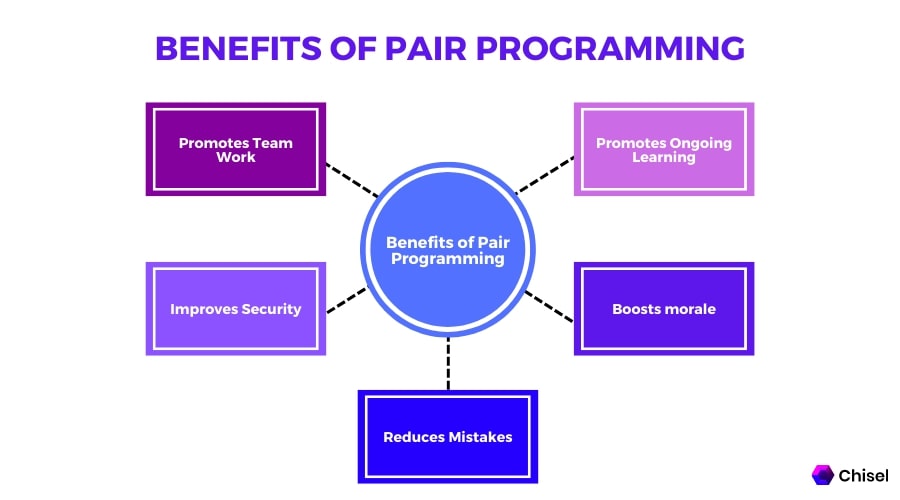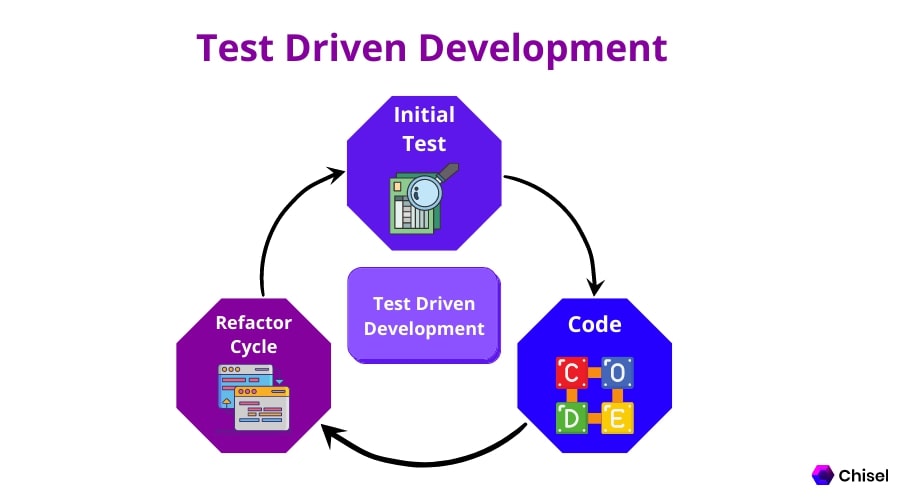
What is Pair Programming?
Pair Programming Definition
Pair programming is a technique wherein two individuals collaborate on a single program. The “driver” writes the code, while the “navigator” checks each line of code for errors.
Pair programming is a software methodology in agile in which two programmers work together on a single workstation.
While one programmer, called the developer, writes the code, the other programmer, called the observer or navigator, reviews every code line as it gets typed.
If the two programmers work together efficiently, it can significantly reduce the development time, improve code quality, and decrease human error.
The programmers may also swap roles every few minutes to keep things fresh and lively in pair programming.
It also helps the programmers share their knowledge by providing continuous feedback and insights on the code. (Tap here to learn more about Chisel, the best product management software.)

Pair programming and TDD
TDD (Test Driven Development) is a programming method in which we write a test first and then implement it.
Not just using TDD and pair programming and developing using clean code and DDD (Domain Driven Design) concepts are some of the most effective techniques. It helps to keep the codebase maintainable.
It plays out, especially when working on a complex domain and business logic project.
When you have people who have been taught in TDD and can guide new programmers, pair programming using TDD is an excellent approach.
Teaching TDD is crucial because numerous incorrect methods are displeased with TDD.
Most programmers connect by pairing programming to solve an issue without using TDD.

How does pair programming work?
One person is the “driver,” and the other is the “navigator” in pair programming. The driver is the individual who is actively writing code at the keyboard. The navigator looks around, double-checks the code, and maintains an eye on the larger picture.
Pair programmers alternate duties frequently to keep both pairs engaged. They also collaborate on deciding which tasks to complete.
When working in a team, developers take turns playing two roles. At the same time, one programmer is the driver. Writing the code, another one is the navigator, reviewing the code and providing all necessary directions and information to the former.
The objective is to alternate these responsibilities at 15-minute to 1-hour intervals.
Some businesses employ pair programming, whereas others do not. That’s because pair programming has both benefits and drawbacks that you should think about before applying it in your organization.
How to do pair programming remotely?
Traditional pair programming and remote pair programming are very similar.
Pair programming involves you and another software developer (or prospective software developer) sitting in front of a computer. And taking turns typing code using only one keyboard.
The driver is the one who is typing on the keyboard.
They will be in charge of considering the classes, variables, functions, and algorithms that must get coded for the program to achieve its goal.
As they code, this individual will strive to verbalize as much of their thought process as possible.
The navigator is the other person. They’ll sit next to the driver, but they won’t be writing any code.
Instead, the navigator will pay close attention to the code the driver is producing and will offer advice and ideas as needed.
The navigator will offer suggestions and research answers to impending concerns and challenges. Also, works as a sounding board for the driver’s thoughts.
The Driver and Navigator will trade roles regularly. Thus the navigator will now be the driver and create the code. You can change responsibilities every 30–40 minutes or whenever you finish developing a particular feature or function.
What are the strategies for effective pair programming?
Make plans together:
Plan what you’ll do and your objectives before you begin programming. Is this a new construction project? Troubleshooting? Are you looking for someone to mentor a junior developer?
Make sure you and your partner are on the same page. The most experienced developer may be in charge of planning, but this isn’t necessary. Plan with your partner and include them in the process.
Prepare for your pair programming session by following these steps:
- What is the goal, the task?
- The session’s duration
- When should positions be changed?
- Any interests that you have
Among the most significant errors developers make is swapping roles too frequently or not when it comes to pair programming.
The frequency with which you must switch roles gets determined by your degree of experience. And the duration of the session.
You can only swap one time if the session is less than 60 minutes long. Having only one person lead could be more efficient if the session is shorter, but you can still switch halfway through.
Ensure to have a good internet connection and be in a place without much noise:
It’s good to turn on your video camera when pair programming, even if it’s unnecessary.
What you say is crucial. Your colleague will be more engaged if you use a video camera. Both parties can have a more enjoyable session.
Always utilize headsets for audio communication. You don’t need to go overboard with expensive professional audio equipment.
Everything which makes you feel at ease would suffice. A headset that allows you to hear the other person clearly and that they can understand you is sufficient.
Limit micromanagement:
A developer micromanaging during a pair programming session is one of the most unpleasant behaviors.
It is more common than you might think, and it defeats the point of pair programming. To create a safe atmosphere for collaboration that encourages developers to share their knowledge.
Stay courteous:
The matching experience is made even worse by a lack of patience. When dealing with persons of varying skill levels, this might happen. Especially if a more experienced developer doesn’t give their partner enough time to comprehend their code.
It may be tempting to break their flow to rectify faults rapidly, but this would harm their flow and confidence. You can always pen down your thoughts and come back to them later.
It will allow you to determine whether the issue is truly one that needs to get addressed or if it got previously discussed.
Stay away from external distractions:
There are numerous hurdles and distractions to overcome, especially while working remotely. Notifications by phone, emails, and door-to-door delivery, for example.
If you are leading the pair programming, these distractions are simpler to deal with. Still, you may drift away occasionally if you are following.
While pairing, ignore any emails or other media. Schedule meetings that will not interfere with your session. Take pauses and set aside time for things other than programming.
Continuous interactions:
Pair programming can be complicated. It’s easier when one person has difficulties keeping up or feels like they’re working alone. To avoid this, communicate with your partner. It will make the session more interactive.
What are the examples of pair programming?
Junior specialized education:
Juniors write code while senior or mid-level devs navigate. Senior specialists are in charge of coding and instructing their junior colleagues. Junior developers learn to tackle problems much faster when they work in pairs.
Senior developers point in the right direction. At the same time, junior developers need to figure out how to address the problems independently.
Enrollment:
Pair programming in recruitment is an excellent technique for applying a developer to the test. An applicant is paired with an experienced worker and given a specific task to complete.
As a navigator, this seasoned employee assesses the candidate’s abilities and determines whether or not they will succeed in this position.
Here you can assess technical capabilities and communication skills and the capacity to operate in a group.
FAQs
Pair Programming helps reduce mistakes, increase code quality, learning, and improve team morale.
The programmer writing the code is called the developer while the programmer reviewing the code and providing feedback is called the observer or the navigator.
Ken Becks, the Agile Manifesto signer and developer of extreme programming invented pair programming.
